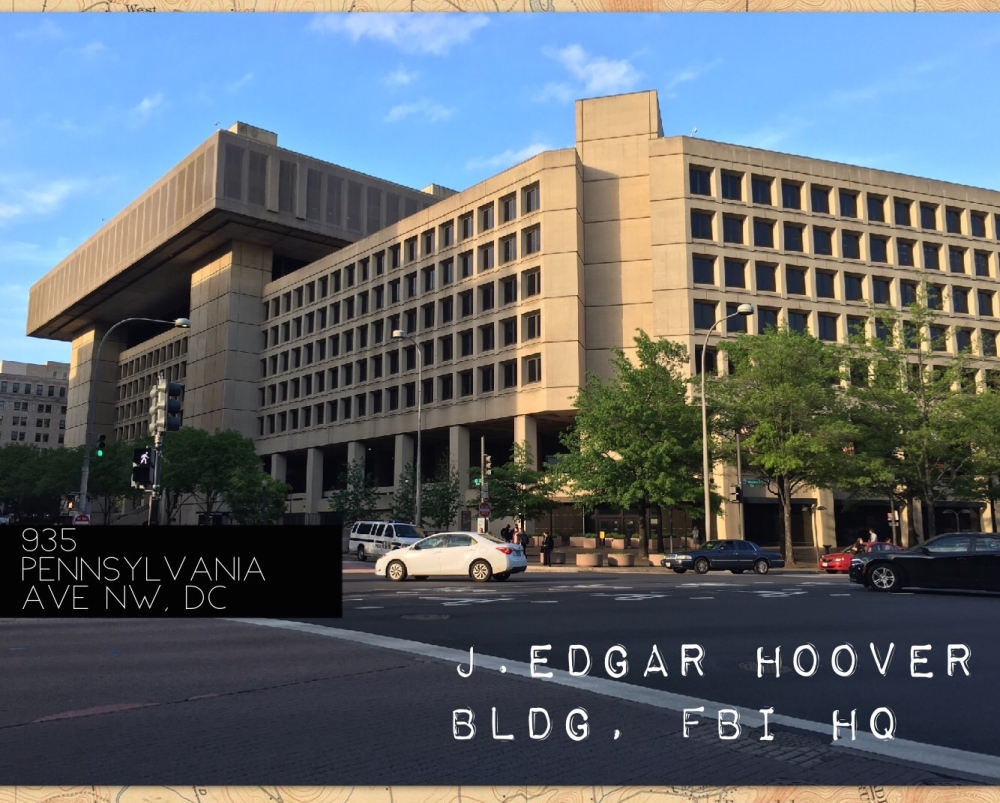J. Edgar Hoover Building
Location: 935 Pennsylvania Ave NW D.C.
Year: Completed in 1975
Dedicated by: President Gerald Ford
Architecture firm: Murphy and Associates
Architecture: Brutalist
Historic Bite/TL;DR: The Hoover Building takes its name from John Edgar Hoover. Since its planning began in 1962, the site was formally selected to be the headquarters of the Federal Bureau of Investigation (FBI) of the United States. However, throughout the years it has been criticized for its cost, design, lack of maintenance, and urban planning. Today it is barely functional.

Often maligned as downtown D.C.’s ugliest edifice, the Hoover building was praised in its early days. The planning began with the Kennedy administration after JFK took notice of the state of ruin marked in Pennsylvania Ave by its deteriorating homes, shops, and office buildings as juxtaposed to the pretty Neoclassical Federal Triangle next door. A proposed spending of $60 million was allocated for the headquarters of the FBI, along with a recommendation to build more, new federal structures to accommodate a growing government (almost no new office buildings in the city had been constructed since the Great Depression). The budget passed and the preliminary design phase began.
“[The FBI Building is] ‘gutsy and bold’ …masculine, no-nonsense architecture appropriate for a national police headquarters. It is a promising beginning for the new Pennsylvania Avenue.” – Wolf Von Eckardt, 1964. Washington Post architectural critic.
Originally designed in a similar monumental fashion to its neighbor agencies, the approach was rejected by the Government Accountability Office for “wasting space” and being too “lavish” for us, taxpayers. So after many changes and delays, the structure took a Chicago school design style, but final Brutalist touch with its poured concrete cover. The delays due to changes, back-and-forths, and funding led not only to a slow construction, but also raised the total cost to $126.108 million… How’s that for lavish!
“The building is Orwellian, alien to the spirit of the capital, and an overly dramatic and utterly miscarried play of forms. [The interior is] a drab factory with harsh light, endless corridors, hard floors and no visual relief.” – The same Wolf Von Eckardt after the completion of the building, 1975.
For the past years, the Hoover Building has been suffering from deterioration due to deferred maintenance and mediocre design, and it’s now up for potential replacement. It is in such bad condition that in 2013, the FBI, General Services Administration (GSA), and Government Accountability Office agreed that the building is no longer appropriate for the FBI and announced a call for proposals from developers. After receiving enough interest from viable projects, the FBI will be vacating and relocating somewhere in Virginia or Maryland, and the Hoover Building …well, who knows 😦
+ Fun Facts:
- Having led the FBI for nearly half-century, J. Edgar Hoover was born and resided in D.C. his entire life.
- The Hoover Building is highly secured with tight access points, has numerous amenities, has three floors below-ground, and is bomb-proof in its first few stories. Some incredible amenities to highlight:
- Automobile repair shop
- Two-story basketball court
- Film library
- Firing range
- Morgue
- The FBI immediately closed the second-story pedestrian observation deck for security reasons when the building opened in 1975.
- It has not been reopened to the public since (Booo!).
- The agency suspended the only public tours of the Building in the wake of the September 11 attacks. The tours remained suspended as of November 29, 2016.
- Back when Donald Trump was just a real estate developer, he was one of the many that expressed interest in redeveloping the Hoover Building. Of course, it was a long shot for his firm which had never constructed any kind of secure federal campus.
- The structure is eight stories high on the Pennsylvania Avenue NW side, and 11 stories high on the E Street NW side. Two wings connect the two main buildings, forming an open-air, trapezoidal courtyard. Here’s the lego model to prove it:

- FBI mid- and low-level managers were said to have meddled extensively in the building’s details, even while working drawings were being completed. No wonder the structure is falling today.
- Parts of the building have been covered in netting to prevent falling chunks of concrete from hitting the sidewalk.
- Current agency’s employees are scattered among about two dozen annex buildings in the Washington region because the building is inhospitable.
- Not to be Debbie Downer, but the White House has also not nominated anyone to lead the General Services Administration, which oversees federal property. So, the years-long effort to build a new headquarters for the Federal Bureau of Investigation faces infinite delay.

